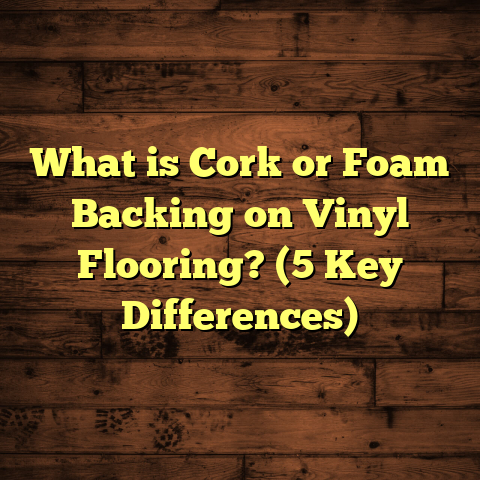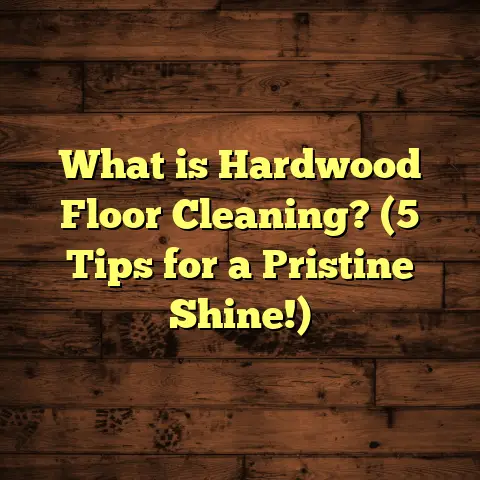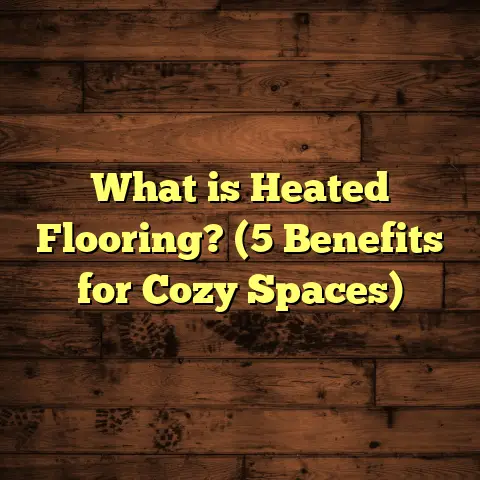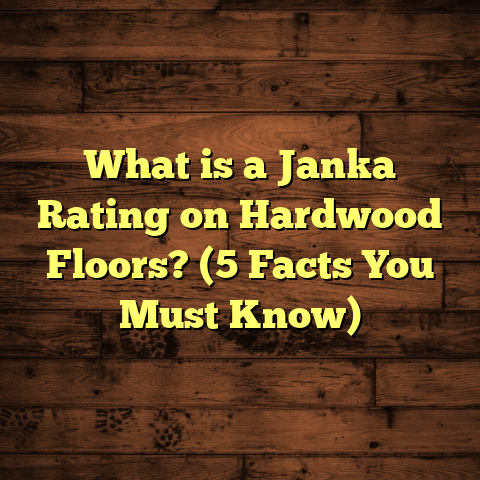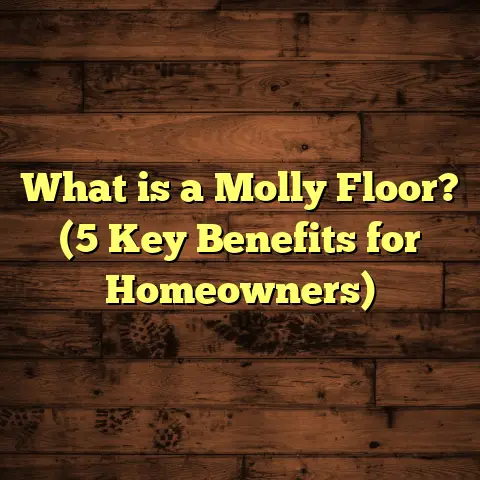What is a Vapor Barrier Under Laminate Floors? (5 Reasons to Install)
Have you ever looked at a laminate floor that started out perfect but then, after a few months or years, showed signs of damage like warping, swelling, or even a musty smell? It’s frustrating and can cost a lot to fix. From my experience as a flooring contractor, one of the biggest reasons this happens is moisture—moisture that you don’t see but that silently works its way up from beneath the floor. And that’s where something called a vapor barrier comes in.
I want to share what I’ve learned about vapor barriers under laminate floors: what they are, why they matter so much, and why I always recommend installing one. Over the years, I’ve seen firsthand how adding this often-overlooked layer can make the difference between a floor that lasts and one that fails prematurely.
What is a Vapor Barrier Under Laminate Floors?
Let’s break it down simply. A vapor barrier is a thin sheet or membrane placed between the subfloor (often concrete or plywood) and the laminate flooring itself. Its job is to stop moisture from below from seeping up into your laminate planks.
Laminate floors have several layers: a wear-resistant top layer, a decorative image layer, and a core usually made of fiberboard or high-density fiberboard (HDF). That core can absorb water like a sponge if exposed to moisture. When it does, the fiberboard swells and warps, which ruins the floor’s look and structure.
The vapor barrier acts like an invisible shield. It prevents water vapor—tiny molecules of moisture in the air—from coming up through concrete slabs or damp wood subfloors and reaching the laminate. Without it, moisture can cause all sorts of issues inside your floor.
Different Types of Vapor Barriers
- Polyethylene Sheeting: This is the most common vapor barrier material. It’s plastic sheeting usually 6 mil (0.006 inches) thick or more. It’s durable and inexpensive.
- Foam Underlayments with Vapor Retarders: Some underlays combine cushioning foam with a built-in vapor barrier layer. These not only block moisture but make walking on laminate softer and quieter.
- Specialized Membranes: Certain high-end products are designed for extreme moisture control or specific subfloor types.
I often tell clients that while these options might look like small details, they play a big role in keeping your floor safe.
Why Do Moisture Problems Happen Beneath Floors?
Moisture isn’t always obvious. Concrete slabs are porous—they absorb water from the ground or humidity in the air and slowly release it over time. This process is called “vapor transmission.” Even if your home seems dry, moisture moves up through the slab and into anything placed on top unless blocked.
Wood subfloors can trap humidity too, especially in basements or humid climates. Seasonal changes cause wood to expand and contract with moisture content fluctuations, which stresses laminate floors laid on top.
Think of it like this: You wouldn’t put paper towels on a wet surface without protection if you want them to stay dry. Your laminate floor feels the same.
Five Reasons I Always Insist on Installing a Vapor Barrier
1. Stops Moisture Damage Before It Starts
Moisture damage is the most common cause of laminate floor problems I encounter. Without a vapor barrier, water vapor sneaks up and is absorbed by the fiberboard core of laminate planks. This causes swelling, buckling, warping, and eventually irreparable damage.
In one project I handled in a basement apartment renovation, the initial installer skipped the vapor barrier to save money. Within 3 months, the floor near an exterior wall started cupping badly. Moisture testing revealed relative humidity levels above 75% below the floor—way too high for laminate without protection. After adding a proper vapor barrier and replacing damaged planks, the problem stopped.
The data backs this up: according to research by the National Wood Flooring Association (NWFA), about 70% of all laminate floor failures are linked to moisture problems originating from below.
2. Makes Your Floor Last Longer
If you want your laminate floors to stay beautiful for years, blocking moisture is key. Studies show that floors installed with vapor barriers last 30-40% longer on average than those without—especially in basements or ground-level installations.
I’ve seen floors last 15+ years with no visible damage when installed over a good vapor barrier versus ones needing repairs or full replacement within 5 years when moisture was allowed in.
Manufacturers often require vapor barriers as part of their warranty terms. Skipping it can void your warranty completely—meaning you’re on your own if damage occurs.
3. Prevents Mold and Mildew Growth
Moisture trapped under floors creates perfect conditions for mold and mildew to grow. Besides smelling unpleasant, mold spores can cause serious health problems like allergies or asthma.
I’ve worked with homeowners who experienced unexplained respiratory issues until we discovered mold growing unseen beneath their floors due to missing or damaged vapor barriers.
Installing a vapor barrier reduces moisture buildup and lowers the risk of mold dramatically.
4. Adds Comfort and Noise Reduction
Many vapor barriers come combined with foam underlayments. This makes walking on laminate softer and quieter by absorbing sound and reducing impact noise.
In one apartment project where noise was an issue between units, installing a vapor barrier with foam padding made a noticeable difference in sound transmission and overall comfort.
This dual purpose makes certain vapor barriers great choices—not only protecting floors but improving living quality.
5. Saves Money in Repairs and Energy Costs
You might think skipping a vapor barrier saves money upfront—but it often leads to higher costs later repairing damage or replacing floors prematurely.
A homeowner survey found that those who skipped vapor barriers spent 25% more on floor repairs within five years on average compared to those who included them.
Additionally, some vapor barriers with insulating properties can help reduce energy bills by limiting cold drafts through concrete slabs.
My Experiences That Prove Vapor Barriers Make All The Difference
When I first started in flooring, I underestimated how important vapor barriers were. Early on, I installed laminate flooring over plywood subfloors without adding any moisture protection because the space seemed dry.
A few months later, clients called complaining about swollen edges and gaps between planks. I tested moisture levels under the floor using a probe meter—turns out humidity was creeping in through cracks in the subfloor.
We had to remove parts of the floor and install a polyethylene vapor barrier retroactively—a frustrating extra step that cost time and money.
Since then, every project I do over concrete or wood subfloors gets a proper vapor barrier as standard practice—even if clients don’t ask for it specifically.
This small step saves headaches later and keeps floors looking great longer.
How to Choose the Right Vapor Barrier for Your Laminate Floor
Not every vapor barrier fits every situation. Here’s what I focus on when selecting one:
- Material Thickness: For concrete slabs, I recommend polyethylene sheeting at least 6 mil thick for durability against punctures during installation.
- Permeance Rating: This measures how much moisture can pass through per hour per square foot (perm rating). Aim for less than 0.1 perm for effective barriers.
- Underlayment Combo: Foam-cushioned underlayments with built-in vapor barriers offer added comfort but may be pricier.
- Compatibility: Always check your laminate manufacturer’s guidelines regarding acceptable vapor barriers to keep warranties intact.
- Installation Ease: Some products come with adhesive backing or pre-cut sheets making installation easier for DIYers.
Step-by-Step Installation Tips from My Toolbox
If you want to install a vapor barrier yourself or help oversee your contractor’s work, here’s what I recommend:
- Prepare Subfloor: Make sure concrete or plywood is clean, dry, and free of debris.
- Lay Barrier Flat: Roll out polyethylene sheeting smoothly without wrinkles or bubbles.
- Overlap Seams: Overlap sheets by at least 8 inches; seal seams tightly with waterproof tape.
- Extend Up Walls: Run barrier slightly up walls before installing baseboards for total protection.
- Avoid Punctures: Be careful not to puncture or tear barrier during plank installation.
- Dry Subfloor First: If concrete was recently poured, allow sufficient curing time (usually 28 days) before installing.
- Use Vapor Barrier Tape: Tape all joints securely so no gaps remain where moisture can sneak through.
What Does Research Say About Vapor Barriers?
There’s solid science behind what I’ve learned on jobsites:
- A 2019 study by Building Science Corporation showed installing polyethylene vapor barriers reduced moisture content in subfloor materials by up to 60%, preventing common laminate failures.
- The U.S. Department of Energy recommends installing vapor barriers over concrete slabs in all climate zones except very dry desert areas.
- Industry statistics reveal homes without vapor barriers under laminate floors have three times higher rates of water damage claims compared to those with them.
These findings align well with my hands-on experience across hundreds of installations.
Common Questions About Vapor Barriers
Q: Can I install laminate directly over concrete without a vapor barrier?
A: You technically can—but it’s risky unless the slab has been treated or sealed properly against moisture. Most manufacturers recommend always using one for safety.
Q: How thick should my vapor barrier be?
A: At least 6 mil (0.006 inches) polyethylene sheeting is standard for concrete slabs. Thinner options aren’t as durable or effective.
Q: Can I use just any plastic sheet as a vapor barrier?
A: No. It must be rated for flooring use with low permeability and tear resistance qualities.
Q: Do I need a vapor barrier over wood subfloors?
A: Usually not required unless moisture levels are high—but using one won’t hurt and adds extra protection.
Q: Will a vapor barrier stop all moisture problems?
A: It blocks moisture rising from below but doesn’t prevent leaks from above or spills—those still need prompt cleaning.
Real Case Study: Basement Flooring Gone Wrong (and How Vapor Barriers Fixed It)
I once helped a client who installed laminate floors in their basement without a vapor barrier because their installer said it wasn’t necessary since they had a sump pump system in place.
Within six months, visible buckling appeared along one side of the room near an outside wall. The homeowner was baffled because there were no leaks or flooding events.
Using a moisture meter under the flooring revealed relative humidity levels above 80%—far too high for laminate without protection.
We pulled up affected flooring, cleaned everything thoroughly, then installed a 10 mil polyethylene vapor barrier taped at seams before laying down new laminate planks with foam underlayment on top.
After this fix, no further issues occurred over five years of monitoring.
How Vapor Barriers Impact Flooring Choices
Knowing you’ll have effective moisture protection beneath your laminate opens doors to installing flooring in areas you might otherwise avoid—like basements or ground-level rooms prone to humidity.
It also means you can confidently choose thinner core laminates that are more affordable but sensitive to moisture because they’re protected underneath.
For people debating between hardwood and laminate flooring in basements, the presence of a good vapor barrier reduces risks associated with both materials significantly.
Personal Tips Based on Years of Work
- Never trust that subfloors are dry just because they “feel” dry; always test using moisture meters before installation.
- When installing yourself, don’t rush laying down the vapor barrier—it needs to be perfect.
- Consider combining foam underlayment with your vapor barrier for extra comfort if budget allows.
- Keep extra rolls of waterproof tape handy during installation—sealing seams well is critical.
- If you’re unsure about moisture levels in your home’s foundation slab, consult with professionals who specialize in building science tests before picking flooring materials.
Wrapping Up My Thoughts on Vapor Barriers Under Laminate Floors
If you’re planning to install laminate flooring anywhere near ground level or over concrete slabs, ask yourself this: How much do I want my floor to last without warping or mold problems? From my years of experience seeing both successes and failures, adding a good vapor barrier isn’t just an option—it’s smart protection for your investment.
I’ve helped countless homeowners avoid costly repairs simply by installing this thin but mighty shield beneath their floors right from the start. It’s one of those things you don’t think about until it’s too late—but once you understand its power against moisture damage, you’ll never want to skip it again.
Got questions about choosing or installing the right vapor barrier? Reach out anytime—I’m happy to help make your flooring project smooth and worry-free!
